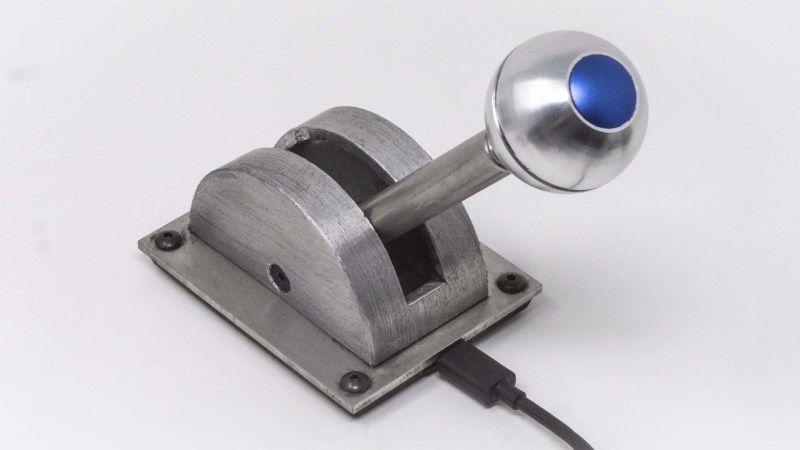If you’re looking to add a little more sci-fi authenticity to your gaming setup, you could do much worse than this functional control lever replica that [ZapWizard] has entered into the Hackaday.io Sci-Fi Contest.
Taking inspiration from Disney’s The Mandalorian, this functional prop is almost identical to the throttle seen on the bridge of the Razor Crest gunship, piloted by the television show’s eponymous bounty hunter. The electronic heart of this build is relatively straightforward – a Trinket M0 measures the resistance of an ultra-thin potentiometer, and masquerades as a typical one-axis USB throttle.
The mechanical components and aesthetically pleasing housing is where this project really shines. Helical 3D printed gears smooth out the movement of the solid aluminum throttle shaft, and a simple detent mechanism ‘catches’ the throttle at the middle point. The ballast and baseplate are cut from stainless steel, giving the throttle considerable heft, aiding in its stability on a tabletop (it’s also possible to secure it down using screws or powerful magnets). The throttle case is 3D printed and covered in aluminum foil tape, which is then chemically blackened and aged for that well-loved appearance.
Of course, the most iconic part of this build is the spherical knob, which screws onto the aluminum shaft for Grogu’s convenience. [ZapWizard] put in an order for one over at Custom 3D Stuff, and it absolutely ties the entire build together.
Interested in prop builds from the world of science-fiction, functional or otherwise? Then take a look through the entries in our Sci-Fi Contest. Or better yet, start building your own entry — there’s still about a month to go before the deadline.
















“Trinket M0 measures the resistance of an ultra-thin potentiometer, and masquerades as a typical one-axis USB throttle.”
Is it masquerading when that is exactly what it is? :)
Makes me wonder if it’s twitchy, pod meters tend to be a tad noisy. Would a rotary encoder from an old mouse (scroll wheel) have worked better? Probably not easier…
Just use a sealed potientiometer as those in good HiFi equipment , they are sealed
so dust and moisture never get inside and it is way easier to just use a joystick emulator boards
and add a few of those .
Magnetic rotary encoders (AMS makes some nice ones) are my favorite.
Magnetic rotary encoders (AMS makes some nice ones) are my favorite!
I wonder why the gearing is necessary, especially since it looks 1:1. It seems like it would have been simpler to just drive the pot directly. Or even simpler, use a magnetic encoder — no mechanical coupling needed.
Also, I wonder how is the friction adjusted, or does it just flop against each endstop?
(no, I didn’t sit through a 40 godforsaken minute video to wait for answers maybe to become evident, and they aren’t in the text description)
When you add a gear into a game device on a lever as such one it is for getting
thye feel of using an actual lever .
If only use a potentiometer on the shaft you only have the feel of the potentiometer and
the resistance in those . By adding a gear you add more feeling into it .
Just like pedals for car race simulators , they add springs and some even hydraulic devices to
get the right feeling as if use a real pedal ( example the brake pedal )
Otherwise it leave no resistance and you just turn a potentiometer .
A nice clever design and good looking too so use gears make totally sense .
So:
“Add some mechanical slop, jitter and resistance to modify the feel to be something realistically imperfect”
is being conflated with:
“Get a position measurement”
Adding a gear to a potentiometer to do both those roles is dumb – you compromise both functions. If you need to add “a gear” to get the exact feel desired, go ahead, but there’s no need to compromise the potentiometer function to do that.
Could also serve for the sped up biological evolution forward/backward control in the original Outer Limits “The Sixth Finger” episode:
https://1.bp.blogspot.com/-3NBcgH5PJAQ/XbYpMcn0o1I/AAAAAAACkLc/Jr1gIJk-vC0f4PqHyADoDsrjPi6zVh2xQCLcBGAsYHQ/s1600/The%2BOuter%2BLimits%2B-%2BThe%2BSixth%2BFinger%2B%25283%2529.png